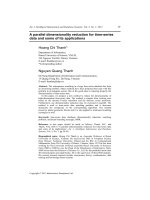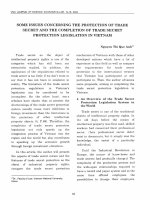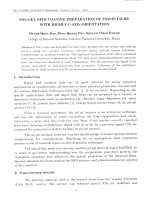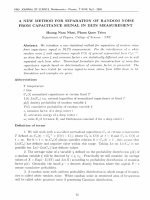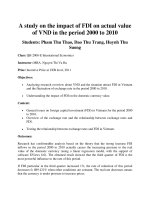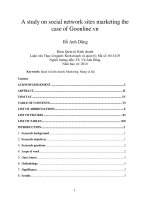DSpace at VNU: A study on the influence of internet addiction and online interpersonal influences on health-related quality of life in young Vietnamese
Bạn đang xem bản rút gọn của tài liệu. Xem và tải ngay bản đầy đủ của tài liệu tại đây (352.9 KB, 8 trang )
������������������������������������������������������������������������������������������������������������������������������������������������������������������������������������������������������������������������������������������������������������������������������������������������������������������������������������������������������������������������������������������������������������������������������������������������������������������������������������������������������������������������������������������������������������������������������������������������������������������������������������������������������������������������������������������������������������������������������������������������������������������������������������������������������������������������������������������������������������������������������������������������������������������������������������������������������������������������������������������������������������������������������������������������������������������������������������������������������������������������������������������������������������������������������������������������������������������������������������������������������������������������������������������������������������������������������������������������������������������������������������������������������������������������������������������������������������������������������������������������������������������������������������������������������������������������������������������������������������������������������������������������������������������������������������������������������������������������������������������������������������������������������������������������������������������������������������������������������������������������������������������������������������������������������������������������������������������������������������������������������������������������������������������������������������������������������������������������������������������������������������������������������������������������������������������������������������������������������������������������������������������������������������������������������������������������������������������������������������������������������������������������������������������������������������������������������������������������������������������������������������������������������������������������������������������������������������������������������������������������������������������������������������������������������������������������������������������������������������������������������������������������������������������������������������������������������������������������������������������������������������������������������������������������������������������������������������������������������������������������������������������������������������������������������������������������������������������������������������������������������������������������������������������������������������������������������������������������������������������������������������������������������������������������������������������������������������������������������������������������������������������������������������������������������������������������������������������������������������������������������������������������������������������������������������������������������������������������������������������������������������������������������������������������������������������������������������������������������������������������������������������������������������������������������������������������������������������������������������������������������������������������������������������������������������������������������������������������������������������������������������������������������������������������������������������������������������������������������������������������������������������������������������������������������������������������������������������������������������������������������������������������������������������������������������������������������������������������������������������������������������������������������������������������������������������������������������������������������������������������������������������������������������������������������������������������������������������������������������������������������������������������������������������������������������������������������������������������������������������������������������������������������������������������������������������������������������������������������������������������������������������������������������������������������������������������������������������������������������������������������������������������������������������������������������������������������������������������������������������������������������������������������������������������������������������������������������������������������������������������������������������������������������������������������������������������������������������������������������������������������������������������������������������������������������������������������������������������������������������������������������������������������������������������������������������������������������������������������������������������������������������������������������������������������������������������������������������������������������������������������������������������������������������������������������������������������������������������������������������������������������������������������������������������������������������������������������������������������������������������������������������������������������������������������������������������������������������������������������������������������������������������������������������������������������������������������������������������������������������������������������������������������������������������������������������������������������������������������������������������������������������������������������������������������������������������������������������������������������������������������������������������������������������������������������������������������������������������������������������������������������������������������������������������������������������������������������������������������������������������������������������������������������������������������������������������������������������������������������������������������������������������������������������������������������������������������������������������������������������������������������������������������������������������������������������������������������������������������������������������������������������������������������������������������������������������������������������������������������������������������������������������������������������������������������������������������������������������������������������������������������������������������������������������������������������������������������������������������������������������������������������������������������������������������������������������������������������������������������������������������������������������������������������������������������������������������������������������������������������������������������������������������������������������������������������������������������������������������������������������������������������������������������������������������������������������������������������������������������������������������������������������������������������������������������������������������������������������������������������������������������������������������������������������������������������������������������������������������������������������������������������������������������������������������������������������������������������������������������������������������������������������������������������������������������������������������������������������������������������������������������������������������������������������������������������������������������������������������������������������������������������������������������������������������������������������������������������������������������������������������������������������������������������������������������������������������������������������������������������������������������������������������������������������������������������������������������������������������������������������������������������������������������������������������������������������������������������������������������������������������������������������������������������������������������������������������������������������������������������������������������������������������������������������������������������������������������������������������������������������������������������������������������������������������������������������������������������������������������������������������������������������������������������������������������������������������������������������������������������������������������������������������������������������������������������������������������������������������������������������������������������������������������������������������������������������������������������������������������������������������������������������������������������������������������������������������������������������������������������������������������������������������������������������������������������������������������������������������������������������������������������������������������������������������������������������������������������������������������������������������������������������������������������������������������������������������������������������������������������������������������������������������������������������������������������������������������������������������������������������������������������������������������������������������������������������������������������������������������������������������������������������������������������������������������������������������������������������������������������������������������������������������������������������������������������������������������������������������������������������������������������������������������������������������������������������������������������������������������������������������������������������������������������������������������������������������������������������������������������������������������������������������������������������������������������������������������������������������������������������������������������������������������������������������������������������������������������������������������������������������������������������������������������������������������������������������������������������������������������������������������������������������������������������������������������������������������������������������������������������������������������������������������������������������������������������������������������������������������������������������������������������������������������������������������������������������������������������������������������������������������������������������������������������������������������������������������������������������������������������������������������������������������������������������������������������������������������������������������������������������������������������������������������������������������������������������������������������������������������������������������������������������������������������������������������������������������������������������������������������������������������������������������������������������������������������������������������������������������������������������������������������������������������������������������������������������������������������������������������������������������������������������������������������������������������������������������������������������������������������������������������������������������������������������������������������������������������������������������������������������������������������������������������������������������������������������������������������������������������������������������������������������������������������������������������������������������������������������������������������������������������������������������������������������������������������������������������������������������������������������������������������������������������������������������������������������������������������������������������������������������������������������������������������������������������������������������������������������������������������������������������������������������������������������������������������������������������������������������������������������������������������������������������������������������������������������������������������������������������������������������������������������������������������������������������������������������������������������������������������������������������������������������������������������������������������������������������������������������������������������������������������������������������������������������������������������������������������������������������������������������������������������������������������������������������������������������������������������������������������������������������������������������������������������������������������������������������������������������������������������������������������������������������������������������������������������������������������������������������������������������������������������������������������������������������������������������������������������������������������������������������������������������������������������������������������������������������������������������������������������������������������������������������������������������������������������������������������������������������������������������������������������������������������������������������������������������������������������������������������������������������������������������������������������������������������������������������������������������������������������������������������������������������������������������������������������������������������������������������������������������������������������������������������������������������������������������������������������������������������������������������������������������������������������������������������������������������������������������������������������������������������������������������������������������������������������������������������������������������������������������������������������������������������������������������������������������������������������������������������������������������������������������������������������������������������������������������������������������������������������������������������������������������������������������������������������������������������������������������������������������������������������������������������������������������������������������������������������������������������������������������������������������������������������������������������������������������������������������������������������������������������������������������������������������������������������������������������������������������������������������������������������������������������������������������������������������������������������������������������������������������������������������������������������������������������������������������������������������������������������������������������������������������������������������������������������������������������������������������������������������������������������������������������������������������������������������������������������������������������������������������������������������������������������������������������������������������������������������������������������������������������������������������������������������������������������������������������������������������������������������������������������������������������������������������������������������������������������������������������������������������������������������������������������������������������������������������������������������������������������������������������������������������������������������������������������������������������������������������������������������������������������������������������������������������������������������������������������������������������������������������������������������������������������������������������������������������������������������������������������������������������������������������������������������������������������������������������������������������������������������������������������������������������������������������������������������������������������������������������������������������������������������������������������������������������������������������������������������������������������������������������������������������������������������������������������������������������������������������������������������������������������������������������������������������������������������������������������������������������������������������������������������������������������������������������������������������������������������������������������������������������������������������������������������������������������������������������������������������������������������������������������������������������������������������������������������������������������������������������������������������������������������������������������������������������������������������������������������������������������������������������������������������������������������������������������������������������������������������������������������������������������������������������������������������������������������������������������������������������������������������������������������������������������������������������������������������������������������������������������������������������������������������������������������������������������������������������������������������������������������������������������������������������������������������������������������������������������������������������������������������������������������������������������������������������������������������������������������������������������������������������������������������������������������������������������������������������������������������������������������������������������������������������������������������������������������������������������������������������������������������������������������������������������������������������������������������������������������������������������������������������������������������������������������������������������������������������������������������������������������������������������������������������������������������������������������������������������������������������������������������������������������������������������������������������������������������������������������������������������������������������������������������������������������������������������������������������������������������������������������������������������������������������������������������������������������������������������������������������������������������������������������������������������������������������������������������������������������������������������������������������������������������������������������������������������������������������������������������������������������������������������������������������������������������������������������������������������������������������������������������������������������������������������������������������������������������������������������������������������������������������������������������������������������������������������������������������������������������������������������������������������������������������������������������������������������������������������������������������������������������������������������������������������������������������������������������������������������������������������������������������������������������������������������������������������������������������������������������������������������������������������������������������������������������������������������������������������������������������������������������������������������������������������������������������������������������������������������������������������������������������������������������������������������������������������������������������������������������������������������������������������������������������������������������������������������������������������������������������������������������������������������������������������������������������������������������������������������������������������������������������������������������������������������������������������������������������������������������������������������������������������������������������������������������������������������������������������������������������������������������������������������������������������������������������������������������������������������������������������������������������������������������������������������������������������������������������������������������������������������������������������������������������������������������������������������������������������������������������������������������������������������������������������������������������������������������������������������������������������������������������������������������������������������������������������������������������������������������������������������������������������������������������������������������������������������������������������������������������������������������������������������������������������������������������������������������������������������������������������������������������������������������������������������������������������������������������������������������������������������������������������������������������������������������������������������������������������������������������������������������������������������������������������������������������������������������������������������������������������������������������������������������������������������������������������������������������������������������������������������������������������������������������������������������������������������������������������������������������������������������������������������������������������������������������������������������������������������������������������������������������������������������������������������������������������������������������������������������������������������������������������������������������������������������������������������������������������������������������������������������������������������������������������������������������������������������������������������������������������������������������������������������������������������������������������������������������������������������������������������������������������������������������������������������������������������������������������������������������������������������������������������������������������������������������������������������������������������������������������������������������������������������������������������������������������������������������������������������������������������������������������������������������������������������������������������������������������������������������������������������������������������������������������������������������������������������������������������������������������������������������������������������������������������������������������������������������������������������������������������������������������������������������������������������������������������������������������������������������������������������������������������������������������������������������������������������������ online relationship demonstrated
significantly higher influences on behaviors and lifestyles
in young Vietnamese with IA. This study also showed that
young Vietnamese with IA were significantly more likely
Table 5 Multivariate linear regression analysis exploring the association between internet use behaviors, other forms of addiction
and health-related quality of life in all participants (N = 566)
EQ-5D index
EQ-VAS
β
95% CI
Internet addiction (Yes vs No)
−4.23*
−7.76
−0.70
β
−0.061*
−0.102
−0.019
Duration of Facebook use/day (hours)
−0.05
−0.27
0.16
−0.002
−0.004
0.001
Shisha smoking (Yes vs No)
−5.78
−13.10
1.54
Alcohol dependence (Yes vs No)
−4.93*
−9.02
−0.84
1.85
−1.68
5.38
0.077*
0.040
0.115
−0.030
−0.064
0.004
95% CI
Talk and meet new online friends (vs Often)
Rarely or never
Effects of online relationships on behaviors, lifestyles and perception (vs High influence)
Moderate influence
−3.94*
−7.48
−0.40
Low influence or no influence
Visit place introduced by online friends (vs Often)
Rarely or never
*p < 0.05
−2.88
−5.87
0.12
Tran et al. BMC Public Health (2017) 17:138
to visit places and engage in activities recommended by
their online friends. These are interesting findings since
no studies to date have explored online interpersonal
influences on lifestyles and behaviors in young people
suffering from IA. These findings serve as a reference and
require further replication in other countries. This is an
expected finding because young Vietnamese with IA are
spending ever-increasing amounts of time on internet.
Internet is the only medium for socialization because the
lack of social support from family and non-online friends
is the main causes of IA [7]. From the cognitive perspectives, people with IA require greater cognitive efforts to
make decision [34]. As a result, they may prefer to seek
advices from online peers to help them deciding on activities or visiting places. From the social perspectives, one
explanation is that young people with IA feel that they are
safer or more comfortable with online communications
[2], especially among those who suffer from IA and loneliness [18]. As a result, young people with IA are more open
to suggestions by their online friends. Not surprisingly,
young Vietnamese with IA spent significantly more time
on social media such as Facebook on a daily basis.
Young Vietnamese with IA were more likely to report
the occurrence of having problems in self-care and
usual activities, pain or discomfort, anxiety or depression. These results are in line with previous research
that has shown associations between IA and minor
mental health morbidity [11, 14, 18]. Our findings confirm that IA could impair psychological well-being of
young Vietnamese. Cao et al. (2009) suggested that
excessive internet use often lead to heightened psychological arousal and result in health problems [14].
Primary care physicians need to assess physical and
mental health status of young people with IA in developing countries. In addition, with regards to the
HRQOL, young Vietnamese with IA had significantly
lower scores in the EQ-5D index and EQ-5D VAS.
These findings correspond to previous reports on IA
and dissatisfaction with life [14]. The current finding
confirms the results of previous research which found
that long duration of internet use leads to functioning
impairments [18]. The regression analysis showed that
IA and alcohol dependence contribute to poor HRQOL
in young Vietnamese. This finding suggests that IA
could be as harmful as alcoholism.
Clinical implications
The present research findings are of importance for
future research on IA in developing countries. Our results help to develop targets for the evidence-based interventions to tackle adverse effects of internet on young
Vietnamese. First, the intervention program must focus
on male and female patients suffering from IA as both
genders are vulnerable to IA. Second, the intervention
Page 7 of 8
program must penetrate all socio-economic sectors in
Vietnam as there were no socio-economic differences
between young Vietnamese with and without IA. Third,
interpersonal psychotherapy is useful to help young
Vietnamese suffering from IA by reducing the online
interpersonal influences on their behaviors and lifestyles.
Social skill training and role play are equally important
to improve off-line communication and relationship. Behavior therapy and activity scheduling will help young
Vietnamese with IA to re-establish daily routines. Fourth,
doctors should assess for physical health problems (e.g.
back pain) and mental health problems (e.g. anxiety and
depression) in young Vietnamese presenting with IA.
Fifth, the health authority should spend resources to
tackle IA because the negative impact of IA on HRQOL
can be as serious as other forms of addiction.
Limitations
This study has several limitations. First, the respondentdriven sampling technique has its own limitation. This
sampling depends on the first participants who determine
the subsequent sampling and researchers have little control
over the sampling method. This process is non-random
and leads to potential sampling bias. Nevertheless, the
respondent-driven sampling technique has its own advantages. This technique allows researchers to reach hidden
population or people with a specific condition such as IA.
Second, this cross-sectional study using online survey did
not allow cause inferences to be drawn and it is possible
that poorer health leads to greater internet use. Third, due
to constraint of the length of online survey, we could not
measure factors including personality and assess off-line
relationship.
Conclusion
This study found that IA is a common problem in young
Vietnamese and the prevalence of IA is among the highest
as compared to other Asian countries. Both genders are at
risk for IA. Our study has contributed to the understanding of important interactions between IA, online interpersonal influences and HRQOL in young Vietnamese. The
findings help health professionals to design evidencebased intervention to tackle adverse online interpersonal
influences associated with IA in young Vietnamese.
Abbreviations
AUDIT-C: Alcohol use disorders identification Test-consumption; EQ-5D5 L: EuroQol - five dimensions - five levels; EQ-VAS: EuroQol -visual analogue
scale; HRQOL: Health-related quality of life; IA: Internet addiction; IAT: Internet
addiction test; RDS: Respondent-driven sampling
Acknowledgements
The authors would like to acknowledge supports by the Vietnam Authority
of HIV/AIDS Control for the implementation of the study.
Funding
There was no funding for this analysis.
Tran et al. BMC Public Health (2017) 17:138
Availability of data and materials
The data that support the findings of this study are available from the
Vietnam Authority of HIV/AIDS Control but restrictions apply to the
availability of these data, which were used under license for the current
study, and so are not publicly available. Data are however available from the
authors upon reasonable request and with permission of Vietnam Authority
of HIV/AIDS Control.
Authors’ contributions
BXT, CAL, LTH, NDH, LHN, BNL, VMN, TDT, MWBZ, RCMH conceived of the
study, and participated in its design and implementation and wrote the
manuscript. LHN, BXT analyzed the data. All authors read and approved the
final manuscript.
Competing interests
The authors declares that they have no competing interests.
Consent for publication
Not applicable.
Ethics approval and consent to participate
Proposal of this research was approved by IRB of the Vietnam Authority of
HIV/AIDS Control. Participants were asked to give E-informed consent and
were informed that they could withdraw at anytime. Their contact information
was coded and ensured to be confidential.
Author details
1
Institute for Preventive Medicine and Public Health, Hanoi Medical
University, Hanoi, Vietnam. 2Bloomberg School of Public Health, Johns
Hopkins University, Baltimore, MD, USA. 3School of Medicine and Pharmacy,
Vietnam National University, Hanoi, Vietnam. 4Institute for Global Health
Innovations, Duy Tan University, Da Nang, Vietnam. 5Department of
Hepatobiliary Surgery, Viet-Duc Hospital, Hanoi, Vietnam. 6Biomedical Global
Institute of Healthcare Research & Technology (BIGHEART), National
University of Singapore, Singapore, Singapore. 7Department of Psychological
Medicine, Yong Loo Lin School of Medicine, National University of Singapore,
Singapore, Singapore. 8Department of Immunology and Allergy, National
Otolaryngology Hospital, Hanoi, Vietnam.
Received: 9 October 2016 Accepted: 22 December 2016
References
1. Tsitsika A, Critselis E, Kormas G, Filippopoulou A, Tounissidou D, Freskou A,
Spiliopoulou T, Louizou A, Konstantoulaki E, Kafetzis D. Internet use and
misuse: a multivariate regression analysis of the predictive factors of
internet use among Greek adolescents. Eur J Pediatr. 2009;168(6):655–65.
2. Casale S, Lecchi S, Fioravanti G. The association between psychological wellbeing and problematic use of Internet communicative services among
young people. J Psychol. 2015;149(5):480–97.
3. Aboujaoude E. Problematic internet use: an overview. World Psychiatry.
2010;9(2):85–90.
4. Young KS. Internet addiction: the emergence of a New clinical disorder.
Cyber Psychol Behav. 1998;1(3):237–44.
5. Ho RC, Zhang MW, Tsang TY, Toh AH, Pan F, Lu Y, Cheng C, Yip PS, Lam LT,
Lai CM, et al. The association between internet addiction and psychiatric
co-morbidity: a meta-analysis. BMC Psychiatry. 2014;14:183.
6. Block JJ. Issues for DSM-V: internet addiction. Am J Psychiatry. 2008;165(3):306–7.
7. Davis RA. A cognitive-behavioral model of pathological Internet use.
Comput Hum Behav. 2001;17(2):187–95.
8. Engelberg E, Sjoberg L. Internet use, social skills, and adjustment.
Cyberpsychology Behav. 2004;7(1):41–7.
9. Chak K, Leung L. Shyness and locus of control as predictors of internet
addiction and internet use. Cyberpsychology Behav Impact Int Multimed
Virtual Real Behav Soc. 2004;7(5):559–70.
10. Caplan SE. A social skill account of problematic internet use. J Commun.
2005;55(4):721–36.
11. Morrison CM, Gore H. The relationship between excessive internet use and
depression: a questionnaire-based study of 1,319 young people and adults.
Psychopathology. 2010;43(2):121–6.
Page 8 of 8
12. Frangos CC, Frangos CC, Sotiropoulos I. Problematic internet use among
greek university students: an ordinal logistic regression with risk factors of
negative psychological beliefs, pornographic sites, and online games.
Cyberpsychology Behav Social Netw. 2011;14(1–2):51–8.
13. Andrews JA, Tildesley E, Hops H, Li F. The influence of peers on young adult
substance use. Health Psychol Off J Division Health Psychol American
Psychol Assoc. 2002;21(4):349–57.
14. Cao H, Sun Y, Wan Y, Hao J, Tao F. Problematic internet use in chinese
adolescents and its relation to psychosomatic symptoms and life
satisfaction. BMC Public Health. 2011;11(1):1–8.
15. Mak KK, Lai CM, Watanabe H, Kim DI, Bahar N, Ramos M, Young KS, Ho RC,
Aum NR, Cheng C. Epidemiology of internet behaviors and addiction
among adolescents in six Asian countries. Cyberpsychology Behav Social
Netw. 2014;17(11):720–8.
16. Li D, Liau A, Khoo A. Examining the influence of actual-ideal selfdiscrepancies, depression, and escapism, on pathological gaming among
massively multiplayer online adolescent gamers. Cyberpsychology Behav
Social Netw. 2011;14(9):535–9.
17. Woo BS, Chang WC, Fung DS, Koh JB, Leong JS, Kee CH, Seah CK.
Development and validation of a depression scale for Asian adolescents. J
Adolesc. 2004;27(6):677–89.
18. Tsai HF, Cheng SH, Yeh TL, Shih C-C, Chen KC, Yang YC, Yang YK. The risk
factors of internet addiction—a survey of university freshmen. Psychiatry
Res. 2009;167(3):294–9.
19. Son DT, Yasuoka J, Poudel KC, Otsuka K, Jimba M. Massively multiplayer
online role-playing games (MMORPG): association between its addiction,
self-control and mental disorders among young people in Vietnam. Int J
Social Psychiatry. 2013;59(6):570–7.
20. Number of internet users in Vietnam from 2014 to 2019 (in millions) [http://
www.statista.com/statistics/369732/internet-users-vietnam/]. Accessed 1 Dec
2016.
21. Wejnert C. PH, krishna N., et al.: estimating design effect and calculating
sample size for respondent-driven sampling studies of injection drug users
in the United States. AIDS Behavior. 2012;16(4):797–806.
22. Cong LM. Internet addiction among students at secondary schools in Bien
Hoa, Dong Nai province. Public Health J. 2011;28:70–8.
23. Young KS. Caught in the net: How to recognize the signs of Internet
addiction – And a winning strategy for recovery. New York: Wiley; 1998.
24. CC F, I S: A Meta-analysis of the Reliability of Young’s Internet Addiction
Test. In: WCE 2012; World Congress on Engineering. London, UK.
25. Pawlikowski M, Altstötter-Gleich C, Brand M. Validation and psychometric
properties of a short version of Young’s internet addiction test. Comput
Hum Behav. 2013;29(3):1212–23.
26. Meerkerk G-J. Pwned by the internet. Explorative research into the causes
and consequences of compulsive internet use. Rotterdam: IVO; 2007.
27. Process of translation and adaptation of instruments [ />substance_abuse/research_tools/translation/en/]. Accessed 1 Dec 2016.
28. Tran BX, Nguyen N, Ohinmaa A, Duong AT, Nguyen LT, Van Hoang M, Vu
PX, Veugelers PJ. Prevalence and correlates of alcohol use disorders during
antiretroviral treatment in injection-driven HIV epidemics in Vietnam. Drug
Alcohol Depend. 2013;127(1–3):39–44.
29. Tran BX, Nguyen LT, Do CD, Nguyen QL, Maher RM. Associations between
alcohol use disorders and adherence to antiretroviral treatment and quality of
life amongst people living with HIV/AIDS. BMC Public Health. 2014;14(1):27.
30. Bradley KA, DeBenedetti AF, Volk RJ, Williams EC, Frank D, Kivlahan DR.
AUDIT-C as a brief screen for alcohol misuse in primary care. Alcohol Clin
Exp Res. 2007;31(7):1208–17.
31. Ha JH, Yoo HJ, Cho IH, Chin B, Shin D, Kim JH. Psychiatric comorbidity
assessed in Korean children and adolescents who screen positive for
Internet addiction. J Clinical Psychiatry. 2006;67(5):821–6.
32. Mythily S, Qiu S, Winslow M. Prevalence and correlates of excessive Internet
use among youth in Singapore. Ann Acad Med Singap. 2008;37(1):9–14.
33. Ni X, Yan H, Chen S, Liu Z. Factors influencing internet addiction in a
sample of freshmen university students in China. Cyberpsychology Behav.
2009;12(3):327–30.
34. Dong G, Huang J, Du X. Enhanced reward sensitivity and decreased loss
sensitivity in internet addicts: an fMRI study during a guessing task. J
Psychiatr Res. 2011;45(11):1525–9.
